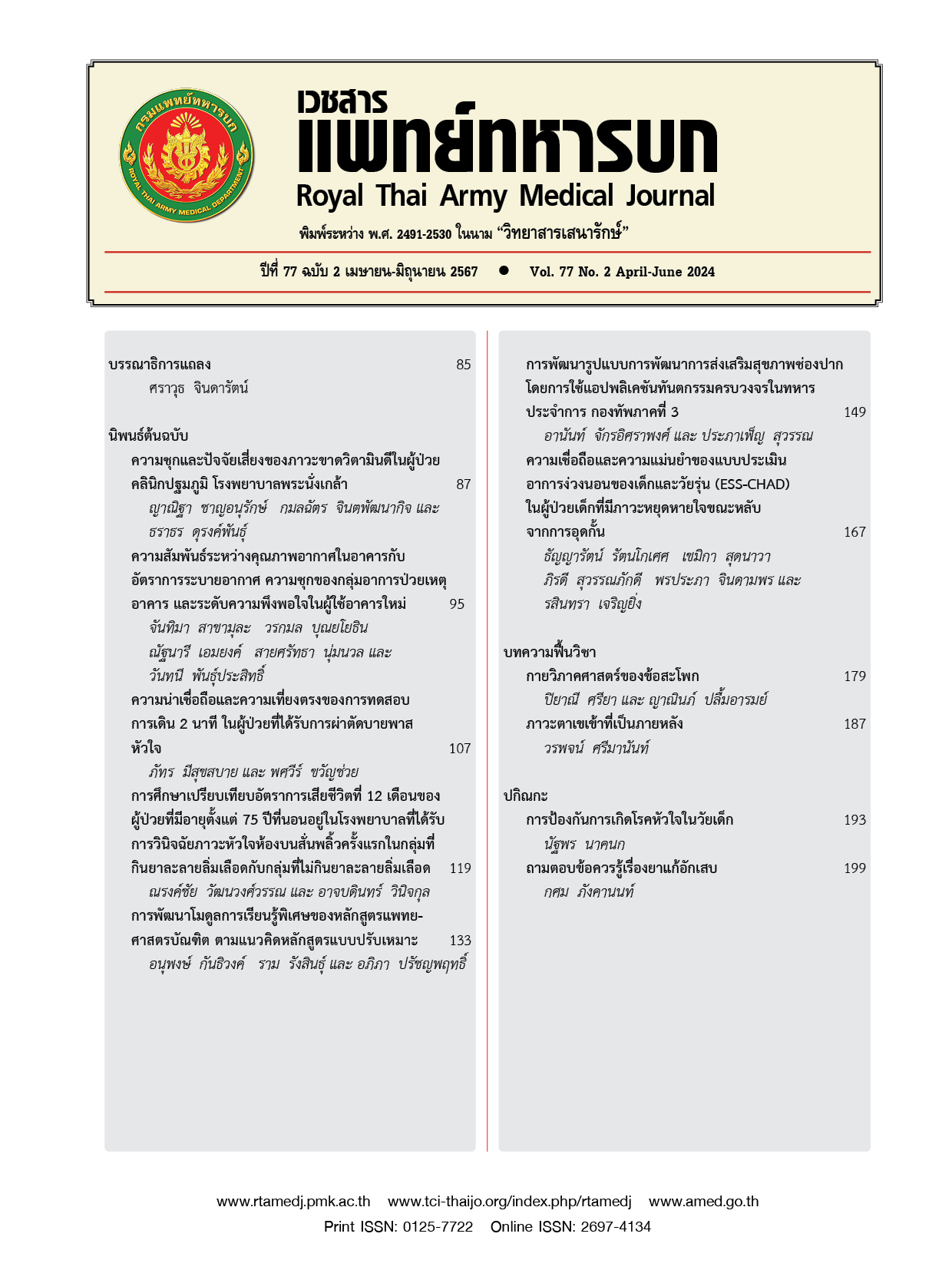ความสัมพันธ์ระหว่างคุณภาพอากาศในอาคารกับอัตราการระบายอากาศ ความชุกของกลุ่มอาการป่วยเหตุอาคาร และระดับความพึงพอใจในผู้ใช้อาคารใหม่
Main Article Content
บทคัดย่อ
ที่มาและความสำคัญ ปัญหาคุณภาพอากาศภายในอาคารใหม่ถือเป็นสิ่งที่สำคัญมาก เนื่องจากคนเมืองส่วนใหญ่ใช้เวลาอยู่ภายในอาคารเกือบทั้งวัน การสัมผัสมลพิษอากาศที่ผ่านการหายใจหรือผิวหนัง จึงเกิดขึ้นได้ขณะที่อยู่ภายในอาคาร การสัมผัสกับคุณภาพอากาศ การระบายอากาศที่ไม่เหมาะสม จะส่งผลต่อการเกิด SBS ได้ วัตถุประสงค์ เพื่อศึกษาความสัมพันธ์ ระหว่างคุณภาพอากาศในอาคารกับอัตราการระบายอากาศ ความชุกของกลุ่มอาการป่วยเหตุอาคาร และระดับความพึงพอใจของผู้ใช้อาคารใหม่ วัสดุและวิธีการ การศึกษานี้เป็นการศึกษาแบบภาคตัดขวาง โดยตรวจวัดอุณหภูมิ ความชื้น ความเร็ว ลม แสงสว่าง ก๊าซคาร์บอนไดออกไซด์ (CO 2) ฟอร์มัลดีไฮด์ สารประกอบอินทรีย์ระเหยง่ายทั้งหมด (TVOC) และฝุ่นขนาดเล็ก รวมทั้งเก็บข้อมูลส่วนบุคคล ประวัติการทำงาน การเจ็บป่วยด้วยกลุ่มอาการป่วยเหตุอาคาร และความพึงพอใจของผู้ใช้อาคารต่อคุณภาพอากาศในอาคารโดยใช้แบบสอบถาม และวิเคราะห์ความสัมพันธ์ของตัวแปรต่าง ๆ ด้วย Chi-Square Test และ Fisher’s exact Test ผลการศึกษา อัตราความชุกของอาการเหนื่อยล้ามีค่าสูงที่สุดคือร้อยละ 47.3 ผู้ที่มีอาการนี้ส่วนใหญ่เป็นผู้ที่อยู่ในพื้นที่ที่อัตราการระบายอากาศต่ำกว่ามาตรฐานแนะนำของสถาบัน American Society of Heating, Refrigerating and Air-Conditioning Engineers (ASHRAE) มาตรฐาน ASHRAE 62.1-2019, Ventilation for Acceptable Indoor Air Quality และคุณภาพอากาศที่ต่ำกว่ามาตรฐานนี้มีความสัมพันธ์กับอาการป่วยอย่างมีนัยสำคัญ (p < 0.05) คือ อุณหภูมิ และCO2 มีความสัมพันธ์กับอาการปวดศีรษะ นอกจากนี้อาการป่วยเหตุอาคารยังมีความสัมพันธ์ กับความพึงพอใจต่อคุณภาพอากาศในอาคารอย่างมีนัยสำคัญ (p < 0.05) คือ อาการป่วยเหตุอาคารมีความสัมพันธ์กับระดับความพึงพอใจด้านอุณหภูมิที่ไม่เหมาะสม สรุป อุณหภูมิ CO2 และอัตราการระบายอากาศเป็นตัวบ่งชี้อาการป่วยและความพึงพอใจของผู้ใช้อาคารที่สำคัญ
Downloads
Article Details

อนุญาตภายใต้เงื่อนไข Creative Commons Attribution-NonCommercial-NoDerivatives 4.0 International License.
บทความในวารสารนี้อยู่ภายใต้ลิขสิทธิ์ของ กรมแพทย์ทหารบก และเผยแพร่ภายใต้สัญญาอนุญาต Creative Commons Attribution-NonCommercial-NoDerivatives 4.0 International (CC BY-NC-ND 4.0)
ท่านสามารถอ่านและใช้งานเพื่อวัตถุประสงค์ทางการศึกษา และทางวิชาการ เช่น การสอน การวิจัย หรือการอ้างอิง โดยต้องให้เครดิตอย่างเหมาะสมแก่ผู้เขียนและวารสาร
ห้ามใช้หรือแก้ไขบทความโดยไม่ได้รับอนุญาต
ข้อความที่ปรากฏในบทความเป็นความคิดเห็นของผู้เขียนเท่านั้น
ผู้เขียนเป็นผู้รับผิดชอบต่อเนื้อหาและความถูกต้องของบทความของตนอย่างเต็มที่
การนำบทความไปเผยแพร่ซ้ำในรูปแบบสาธารณะอื่นใด ต้องได้รับอนุญาตจากวารสาร
เอกสารอ้างอิง
Bandhukun A. Textbook of occupational medicine. Bangkok: Nopparat Ratchathani Hospital, Department of Medical Services, Ministry of Public Health; 2011.
Thetkathuek A. Occupational health and safety. 3rd editions. Bangkok: Odeon Store; 2013. Thai.
Appel AM, Török E, Jensen MA, Garde AH, Hansen ÅM, Kaerlev L, et al. The longitudinal association between shift work and headache: results from the Danish PRISME cohort. Int Arch Occup Environ Health. 2020;93(5):601-10.
ASHRAE. Ventilation for Acceptable Indoor Air Quality. Georgia, United States: ASHRAE; 2019. p. 15–24.
Attia S. Chapter 5 - Occupants Well-Being and Indoor Environmental Quality. In: Attia S, editor. Net Zero Energy Buildings (NZEB). Oxford, United Kingdom: Butterworth-Heinemann; 2018. p. 117-53.
Bureau of Occupational and Environmental Diseases (BOED). Guide to measuring indoor air quality for entry and exit channels into the country. Bangkok, Thailand: Aksorn Graphic and Design; 2018.
Department of Health. Recommended values for air quality inside public buildings. Department of Health, 1 Nov 21, 2022. Nonthaburi: Department of Health; 2022. Thai.
Niyomthu I, Boonchu W, Ngammook K. Promoting indoor air quality. Nonthaburi: Department of Health; 2010. Thai.
Jones B, Molina C. Indoor Air Quality. In: Abraham MA, editor. Encyclopedia of Sustainable Technologies. 2nd editions. Oxford: Elsevier; 2024. p. 322-35.
Mitsikostas DD, Tsaklakidou D, Athanasiadis N, Thomas A. The prevalence of headache in Greece: correlations to latitude and climatological factors. Headache. 1996;36(3):168-73.
Sawanpanyalert P, Benjawang Y, Bovornkitti S. Occupational medicine. Bangkok : JSK printing; 2542.
Sajeev V, Anand P, George A. Chapter 12 - Indoor air pollution, occupant health, and building system controls-a COVID-19 perspective. In: Assadi A, Amrane A, Nguyen TA, editors. Hybrid and Combined Processes for Air Pollution Control. Oxford: Elsevier; 2022. p. 291-306.
Suphatra. Building allergy, silent danger from buildings = Sick building syndrome (SBS). Bangkok: Sangdown; 2010. Thai.
The Government of Hong Kong Special Administrative Region; Indoor Air Quality Management Group. A Guide in Indoor Air Quality Certification Scheme for Offices and Public Places. Hong Kong: The Government of Hong Kong Special Administrative Region; 2019.
Phanprasit W. Indoor Air Pollution Action Manual. Bangkok: Bureau of Health. Environmental Health Division. General Sanitation Department; 2000. Thai.
Punprasit W, Boonyayothin V. Estimating the percentage of air from outside flowing into the room or building (%OA). Thailand Journal of Health Promotion and Environmental Health. 2002;96-104. Thai.
Operational Manual for Indoor Air Quality Assessment For officials. Nonthaburi: Bureau of Environmental Health, Department of Health; 2016. Thai.


